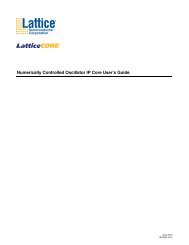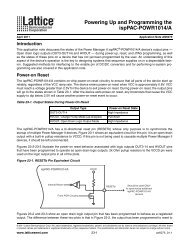DS1036 - Platform Manager Data Sheet - Lattice Semiconductor
DS1036 - Platform Manager Data Sheet - Lattice Semiconductor
DS1036 - Platform Manager Data Sheet - Lattice Semiconductor
You also want an ePaper? Increase the reach of your titles
YUMPU automatically turns print PDFs into web optimized ePapers that Google loves.
37<br />
<strong>Platform</strong> <strong>Manager</strong> <strong>Data</strong> <strong>Sheet</strong><br />
DAC Register I 2 C on the fly to set the trimming voltage to a desired value. The DAC Register I 2 C is a volatile register<br />
and is reset to 80H (DAC at Bipolar zero) upon power-on. The external microcontroller writes the correct DAC<br />
code in this DAC Register I 2 C before enabling the programmable power supply.<br />
Digital Closed Loop Trim Mode<br />
Closed loop trim mode operation can be used when tight control over the DC-DC converter output voltage at a<br />
desired value is required. The closed loop trim mechanism operates by comparing the measured output voltage of<br />
the DC-DC converter with the internally stored voltage setpoint. The difference between the setpoint and the actual<br />
DC-DC converter voltage generates an error voltage. This error voltage adjusts the DC-DC converter output voltage<br />
toward the setpoint. This operation iterates until the setpoint and the DC-DC converter voltage are equal.<br />
Figure 20 shows the closed loop trim operation of a TrimCell. At regular intervals (as determined by the Update<br />
Rate Control register) the <strong>Platform</strong> <strong>Manager</strong> device initiates the closed loop power supply voltage correction cycle<br />
through the following blocks:<br />
Non-volatile Setpoint register stores the desired output voltage<br />
Internal ADC is used to measure the voltage of the DC-DC converter<br />
Tri-state comparator is used to compare the measured voltage from the ADC with the Setpoint register<br />
contents. The output of the tri-state comparator can be one of the following:<br />
+1 if the setpoint voltage is greater than the DC-DC converter voltage<br />
-1 if the setpoint voltage is less than the DC-DC converter voltage<br />
0 if the setpoint voltage is equal to the DC-DC converter voltage<br />
Channel polarity control determines the polarity of the error signal<br />
Closed loop trim register is used to compute and store the DAC code corresponding to the error voltage.<br />
The contents of the Closed Loop Trim will be incremented or decremented depending on the channel polarity<br />
and the tri-state comparator output. If the tri-state comparator output is 0, the closed loop trim register<br />
contents are left unchanged.<br />
The DAC in the TrimCell is used to generate the analog error voltage that adjusts the attached DC-DC converter<br />
output voltage.<br />
Figure 20. Digital Closed Loop Trim Operation<br />
Tri-State<br />
Digital<br />
Compare<br />
(+1/0/-1)<br />
Setpoint<br />
(E 2 CMOS)<br />
<strong>Platform</strong> <strong>Manager</strong><br />
E2 Channel<br />
Polarity<br />
CMOS Registers<br />
(E2 DAC Register 3<br />
TrimCell<br />
CMOS) DAC Register 2<br />
DAC Register 1<br />
DAC Register 0<br />
DAC<br />
TRIMx<br />
DAC Register I2C Profile Control<br />
(CPLD)<br />
+/-1<br />
Update<br />
Rate<br />
Control<br />
CPLD_CLT_EN<br />
Closed Loop<br />
Trim Register<br />
Profile 0 Mode<br />
Control (E 2 CMOS)<br />
The closed loop trim cycle interval is programmable and is set by the update rate control register. The following<br />
table lists the programmable update interval that can be selected by the update rate register.<br />
ADC<br />
VMONx<br />
TRIMIN<br />
VOUT<br />
GND<br />
DC-DC<br />
Converter









